Home >Database >Mysql Tutorial >Issues related to RR and phantom reading in mysql
Issues related to RR and phantom reading in mysql
- WBOYWBOYWBOYWBOYWBOYWBOYWBOYWBOYWBOYWBOYWBOYWBOYWBforward
- 2022-10-11 16:59:022164browse
This article brings you relevant knowledge about mysql, which mainly introduces the relevant content about RR and phantom reading, including the MVCC principle, RR generating phantom reading, and RR solving phantom reading Let’s take a look at the content below. I hope it will be helpful to everyone.

Recommended learning: mysql video tutorial
1. Foreword
This article focuses on these three topics. RR How to solve phantom reading?

- ##MVCC principle
- Experiment: RR and phantom reading
- Case: Deadlock
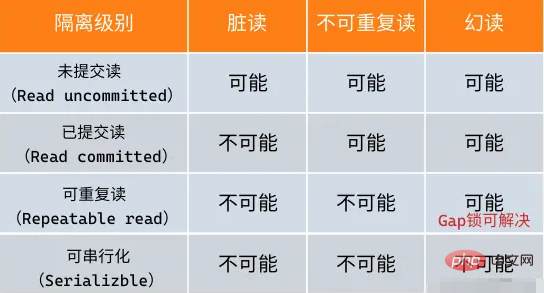
- Read uncommitted: It can read the intermediate process of a transaction, which violates the ACID characteristics and has the problem of dirty reading. It is basically not used.
- Read commit: Indicates that if other transactions have been committed, then you can see it. It is not used much in production environments.
- Repeatable read: the default level, the most used one. It features Gap lock.
- Serializable: All implementations are implemented through locks.
- Dirty reads: A transaction is dealing with When a record is modified, the data of this record will be in an inconsistent state until the transaction is completed and submitted.
- Non-repeatable read: A transaction is read twice according to the same query conditions, and the read data is inconsistent (modification, deletion).
- Phantom reading: Re-query data according to the same query conditions within a transaction, but find that other transactions have inserted new data that satisfies its query conditions.
(1) MVCC multi-version implementation
When MySQL implements the MVCC mechanism, it is based on the undo log multi-version chain ReadView mechanism.- undo log multi-version chain: Every time the database is modified, the transaction number of the current modification record and the storage address of the data state before modification (i.e. ROLL_PTR) will be recorded in the undo log. , so that you can roll back to the old data version when necessary.
- ReadView mechanism: Based on the multi-version chain, control the visibility of transaction reads. (The main difference is: RC and RR)
- A read transaction queries the current record, but the latest transaction has not yet been submitted.
- According to atomicity, read transactions cannot see the latest data, but they can find old versions of data in the rollback segment, thus generating multiple versions.
- RC level transactions: Visibility At a higher level, it can see all modifications of committed transactions.
- RR-level transactions: In a read transaction, no matter what modifications other transactions make to the data and whether they are submitted, the query data results will not change as long as you do not submit them. .
If you use the current read, you will get a new ReadView and you can also see the updated data.
(2) Snapshot read and current read
In MVCC concurrency control, read operations can be divided into two categories:
Snapshot reading: What is read is the visible version of the record (possibly the historical version), without locking.
Operation: Simple SELECT operation.
Current read: The latest version of the record is read, and the record returned by the current read will be locked to ensure that other transactions will not modify this record concurrently.
Operations: special read operations, add/update/delete operations.
-- 对应 SQL 如下: -- 1. 特殊读操作 SELECT ... FOR UPDATE SELECT ... LOCK IN SHARE MODE -- 共享锁 -- 2. 新增:INSERT -- 3. 更新:UPDATE -- 4. 删除:DELETE
Combined with the ReadView mechanism to distinguish: snapshot read and current read:
Snapshot read: In a transaction, ReadView will be obtained only when the first snapshot read is initiated, and subsequent read operations Will not be obtained again.
Current reading: ReadView will be obtained for each read operation.
3. Experiment: RR and phantom reading
Interview question: Under the RR transaction isolation level, transaction A queries a piece of data, transaction B adds a piece of data, and transaction A can see transaction B The data?

This question is relatively vague, but we know that the general inspection point is RR and phantom reading. The question can be divided into two categories:
Under what circumstances, RR produces phantom reading? (Can see the data)
Answer: Current read (SELECT..FOR UDPDATE, SELECT ... LOCK IN SHARE MODE)
Under what circumstances does RR solve phantom reading? (Cannot see data)
Answer: Locking, snapshot reading
Note: Non-repeatable reading focuses on UPDATA and DELETE, while phantom reading focuses on INSERT.
The biggest difference between them is how to solve the problems they cause through the lock mechanism.
The lock mentioned here only uses the pessimistic locking mechanism.
Let’s review again: Phantom reading
-- 举个栗子:有这样一个查询 SQL SELECT * FROM user WHERE id < 10;
Under the same transaction, 4 pieces of data are queried at T1 time, and 8 pieces of data are queried at T2 time. This creates phantom reading.
Under the same transaction, 8 pieces of data are queried at time T1, and 4 pieces of data are queried at time T2. This creates phantom reading.
The experiment preparation is as follows: Hands-on practice
show variables like 'transaction_isolation'; -- 事务隔离级别 RR select version(); -- 版本 8.0.16 show variables like '%storage_engine%'; -- 引擎 InnoDB -- 1. 手动开启事务提交 begin; -- 开始事务 commit; -- 提交事务 -- 2. 创建表 CREATE TABLE IF NOT EXISTS `student` ( `id` INT NOT NULL COMMENT '主键 id', `name` VARCHAR(50) NOT NULL COMMENT '名字', `age` TINYINT NOT NULL COMMENT '年龄', PRIMARY KEY (id) ) ENGINE=InnoDB DEFAULT CHARSET utf8mb4 COLLATE=utf8mb4_unicode_ci COMMENT '学生表'; -- 3. 新增数据用于实验 INSERT INTO student (id, name, age) VALUES (5, 'kunkun', 14); INSERT INTO student (id, name, age) VALUES (30, 'ikun', 18);
(1) RR generates phantom reading
The experiment is as follows: Test current Read
Experiment 1: SELECT first, then SELECT... FOR UPDATE
Experiment 2: SELECT first, then UPDATE (no phantom reading will occur)
Experiment 1: SELECT first, then SELECT... FOR UPDATE
-- 事务A: BEGIN; SELECT * FROM student WHERE id < 30; SELECT * FROM student WHERE id < 30 FOR UPDATE; -- 等待事务B commit 后再执行 -- SELECT * FROM student WHERE id < 30 LOCK IN SHARE MODE; COMMIT; -- 事务B: BEGIN; INSERT INTO student (id, name, age) VALUES (20, 'wulikun', 16); COMMIT;
What happened is as shown in the figure below:
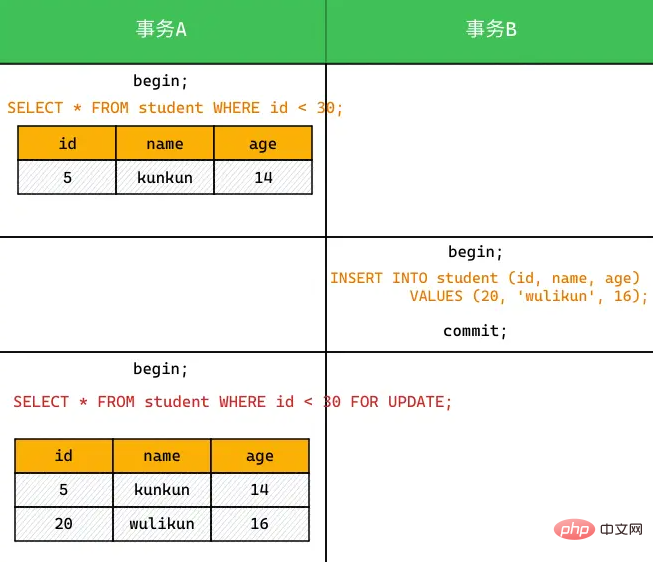
The experimental record is as shown in the figure below:
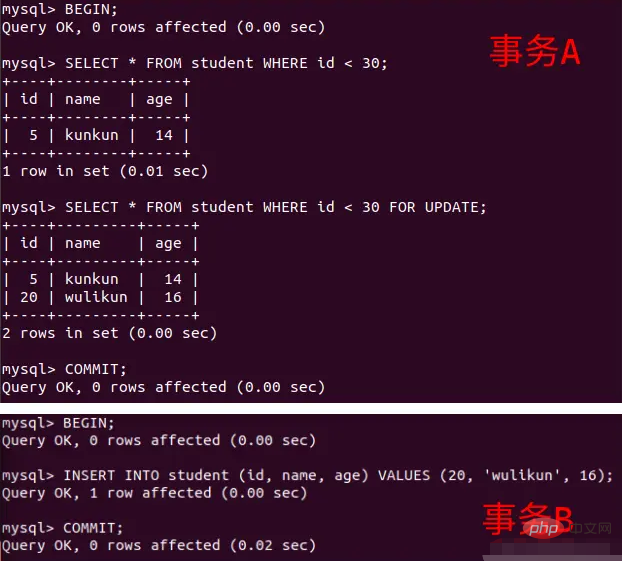
Phenomenon conclusion: When using the current read (SELECT ... FOR UPDATE), phantom reads will occur.
Similarly using SELECT ... LOCK IN SHARE MODE; will produce phantom reads.
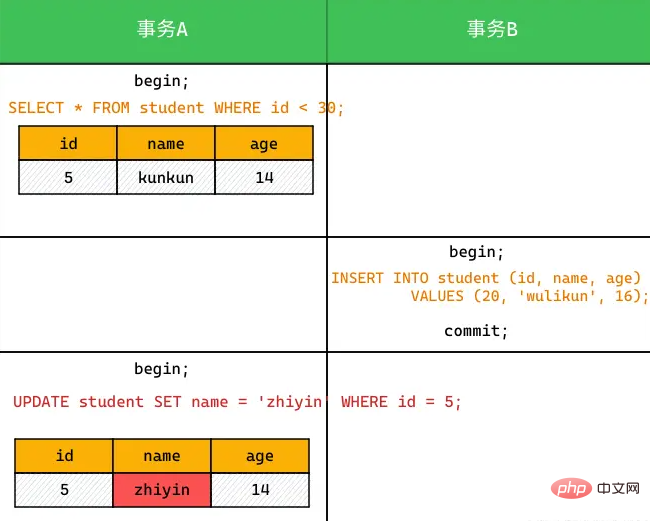
Experiment 2: SELECT first, then UPDATE
-- 事务A: BEGIN; SELECT * FROM student WHERE id < 30; UPDATE student SET name = 'zhiyin' WHERE id = 5; -- 等待事务B commit 后再执行 SELECT * FROM student WHERE id < 30; COMMIT; -- 事务B: BEGIN; INSERT INTO student (id, name, age) VALUES (20, 'wulikun', 16); COMMIT;
What happens is as shown below:

The experimental record is shown in the figure below:
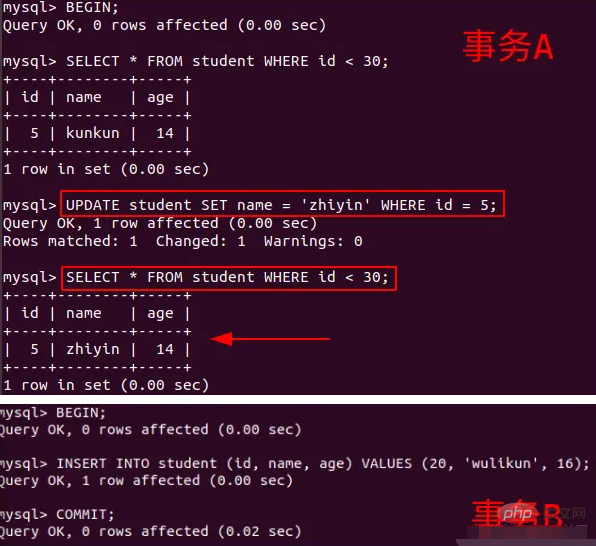
Phenomenon conclusion: The current read (UPDATE) will not produce phantom reads. Neither INSERT / DELETE will do the same.
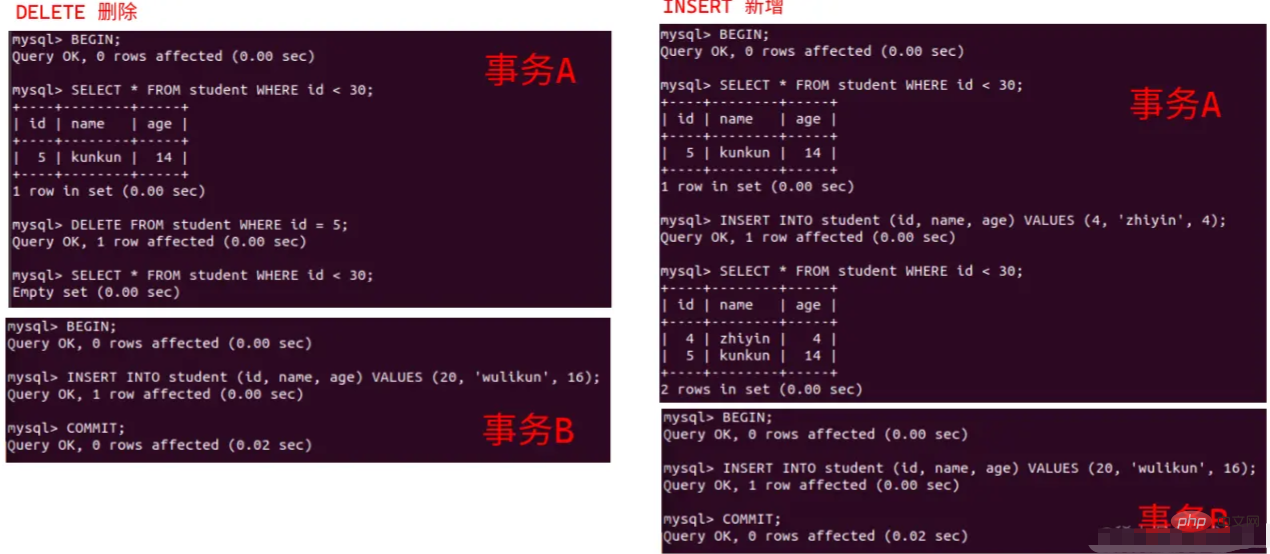
(2) RR solves phantom reading
The experiment is as follows:
Experiment 1: Snapshot reading
Experiment 2: Lock (update non-existent records)
Experiment 3: Add Lock (SELECT ... FOR UPDATE)
Experiment 1: Snapshot read, ordinary SELECT
-- 事务A: BEGIN; SELECT * FROM student; SELECT * FROM student; -- 等待事务B commit 后再执行 COMMIT; -- 事务B: BEGIN; INSERT INTO student (id, name, age) VALUES (20, 'wulikun', 16); COMMIT;
What happens is as shown below:
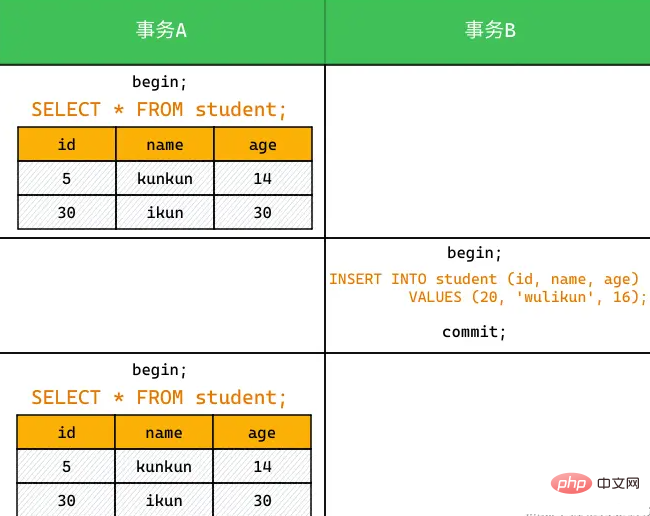
The experimental record is shown in the figure below:
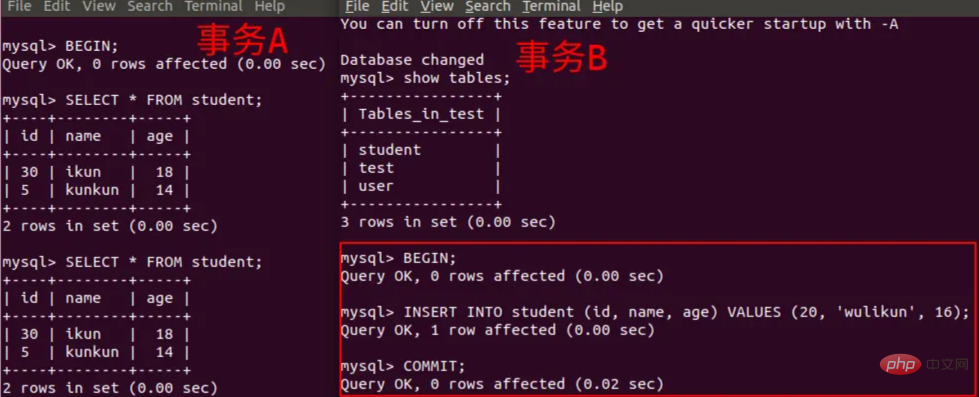
Conclusion of the phenomenon: Under the RR transaction isolation level, only snapshot reads ( SELECT) will not cause phantom reading. There is no current read.
Experiment 2: Locking, (updating non-existent records)
Under the RR isolation level, transaction A uses UPDATE to lock, and transaction B cannot Insert new data between transactions, so that the data read by transaction A before and after UPDATE remains consistent, avoiding phantom reads.
-- 事务A: BEGIN; SELECT * FROM student; UPDATE student SET name = 'wulikunkun' WHERE id = 18; -- 记录不存在,产生间隙锁 (5, 30)。 COMMIT; -- 事务B: BEGIN; INSERT INTO student (id, name, age) VALUES (10, 'zhiyin', 16); -- 需要等待事务A结束。 COMMIT; -- 事务C: BEGIN; INSERT INTO student (id, name, age) VALUES (40, 'zhiyin你太美', 32); COMMIT; -- 查询数据库中当前有哪些锁 SELECT INDEX_NAME,LOCK_TYPE,LOCK_MODE,LOCK_STATUS,LOCK_DATA FROM performance_schema.data_locks;
What happened is as shown below:
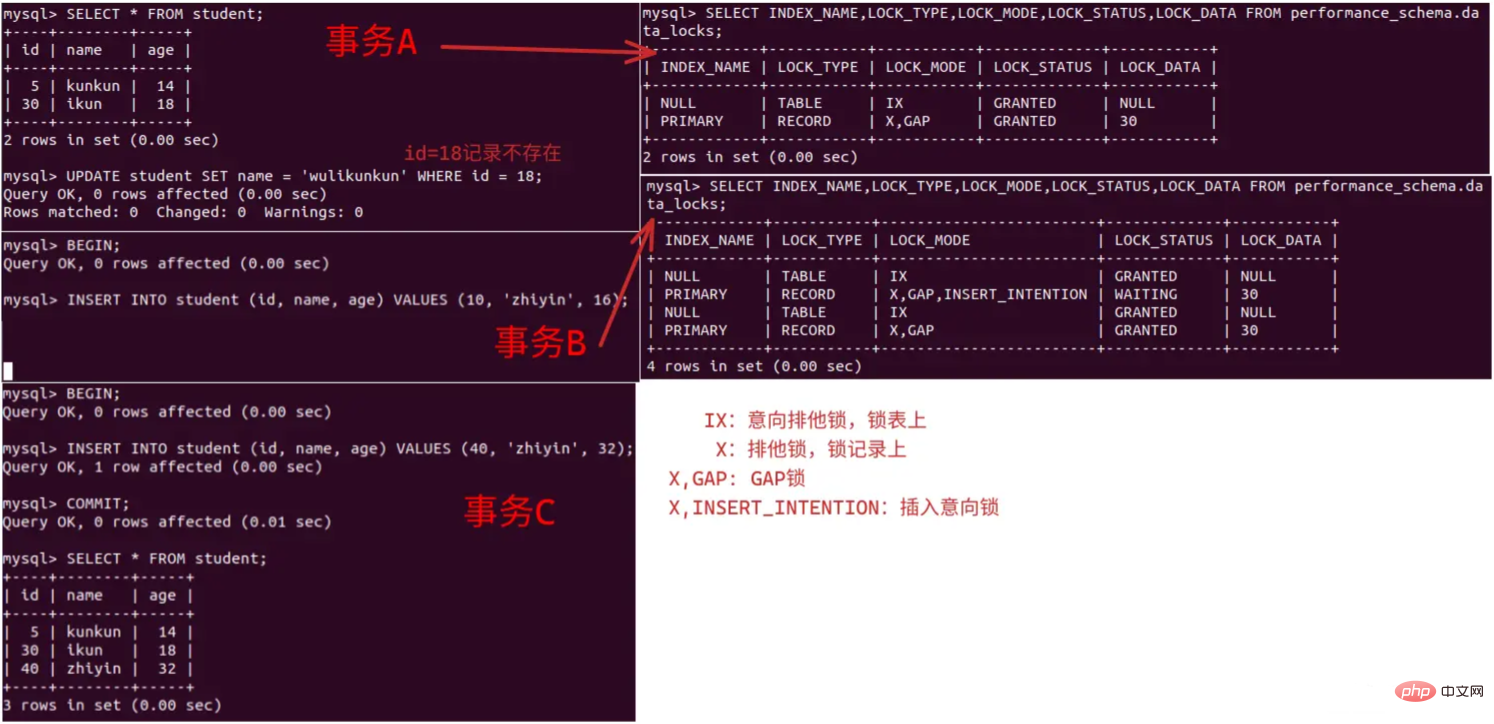
实验记录如下图所示:

现象结论:
一开始先加 临键锁Next-key lock,锁范围为 (5,30]。
因为是唯一索引,且更新的记录不存在,临键锁退化成 间隙锁Gap,最终锁范围为 (5,30)。其余的记录不受影响。
实验三:加锁(SELECT ... FOR UPDATE)
-- 事务A: BEGIN; SELECT * FROM student; SELECT * FROM student WHERE id < 5 FOR UPDATE; COMMIT; -- 事务B: BEGIN; INSERT INTO student (id, name, age) VALUES (4, 'zhiyin', 4); -- 需要等待事务A结束。 COMMIT; -- 事务C: BEGIN; INSERT INTO student (id, name, age) VALUES (5, 'zhiyin你太美', 32); -- 插入成功 COMMIT; -- 查询数据库中当前有哪些锁 SELECT INDEX_NAME,LOCK_TYPE,LOCK_MODE,LOCK_STATUS,LOCK_DATA FROM performance_schema.data_locks;
发生情况如下图所示:
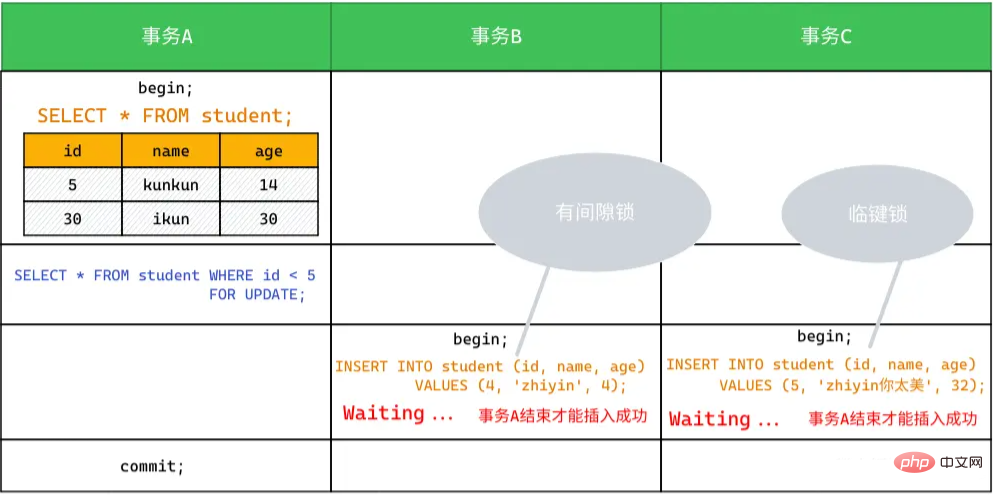
实验记录如下图所示:
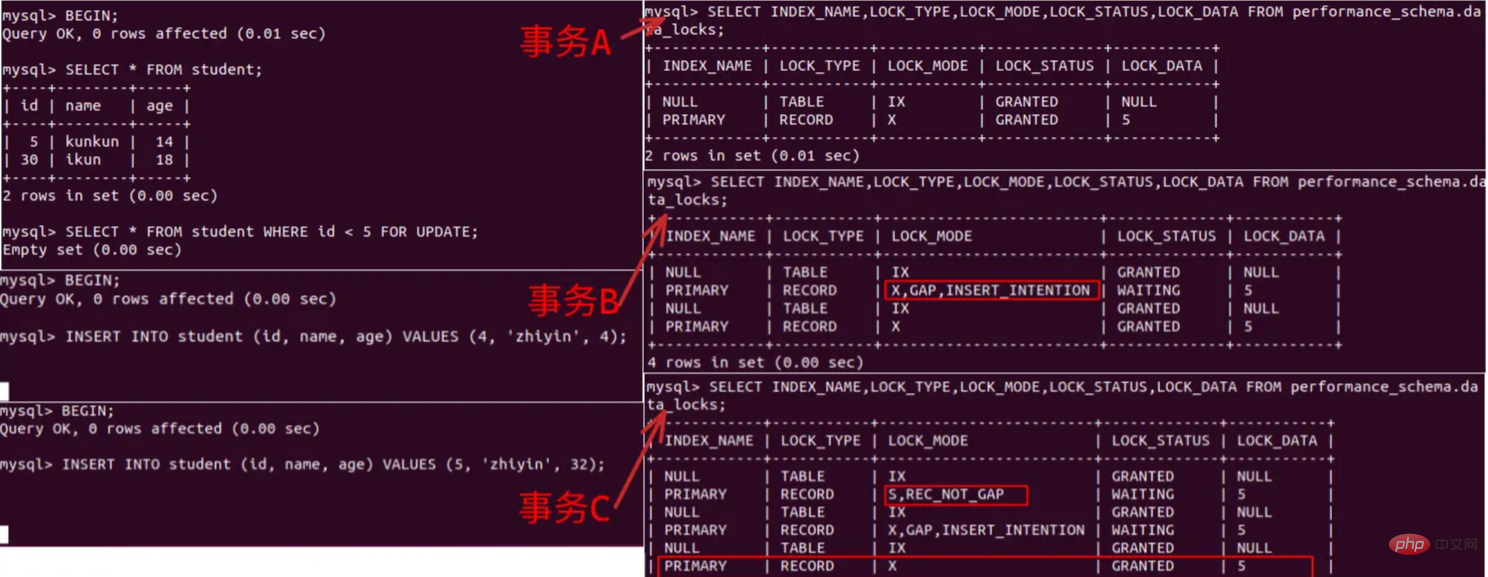
现象结论:
先加 临键锁Next-key lock,锁范围为 (-∞,5]。
所以,id
拓展:Gap 锁(间隙锁)
根据 官方文档 可知:
锁是加在索引上的。
记录锁: 行锁,只会锁定一条记录。
间隙锁 :是在索引记录之间的间隙上的锁,区间为前开后开 (,)。
临键锁(Next-Key Lock): 由 记录锁 和 间隙锁Gap 组合起来。
加锁的基本单位是 临键锁,其加锁区间为前开后闭 (,]。
索引上的等值查询,给唯一索引加锁的时候,如果满足条件,临键锁 退化为 行锁。
索引上的等值查询,给唯一索引加锁的时候,如果不满足条件,临键锁 退化为 间隙锁。注意,非等值查询是不会优化的。
推荐学习:mysql视频教程
The above is the detailed content of Issues related to RR and phantom reading in mysql. For more information, please follow other related articles on the PHP Chinese website!
Related articles
See more- An article to talk about the internal implementation mechanism of Mysql lock
- MySQL slow query log practice (graphic and text analysis)
- 【Must Know】Five important security tips you should take to strengthen MySQL
- How to optimize performance of MySQL? Optimization Tips Sharing
- Summarize and sort out the pitfalls of mysql left join query that is slow and takes a long time

